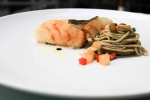Melanzana and Methylcellulose: An Italian Pasta Match Made in Heaven

 Will Blunt
Will BluntRecipe
Interview
Photos
Rome is a city for traditionalists, especially when it comes to food. The natives don’t want to stray too far from their potato gnocchi or porchetta, and tourists still expect tiny trattorias with guitar-playing waiters and checkered tablecloths.
But every now and then, an Italian chef comes around who’s all too happy to upend that tradition—taking, for instance, the revered eggplant (or melanzana to you non-Italian speakers) and meshing it with a molecular hydrocolloid.
Enter Cristina Bowerman, whose upstart restaurant Glass Hostaria had originally so outraged locals that they’d actually called police in an effort to root out the brazen chef from their sacrosanct Trastavere neighborhood. Fast forward a few years, and Bowerman and her restaurant are now well received, thanks in part to her blend of a chemical engineering background, a focus on culinary historicism (more than a nod to tradition), and an off-cut derring-do approach.
Her White Fish, Curry, Coconut, and Eggplant Spaghetti is the perfect example of her willingness to give the Eternal City a makeover using el Bulli-esque molecular wizardry. In this case, she starts with tradition, wrapping eggplant in foil and smoking it over an open flame. “The foil creates a chamber that infuses them with smoke,” she says. After getting the smoky, flavorful pulp, she mixes it with methylcellulose, a gelling agent, to create her eggplant spaghetti.
A vegetable derivative, methylcellulose is the Bizarro ingredient of the molecular pantry, as its pretty much the complete opposite of almost every other gelling agent. Unlike gelatin, which firms up when cold, methylcellulose gels only when hot. When methylcellulose is cold it thickens; when warm, it aerates and helps make foams, and when it is heated first and then cooled, it melts. Because of these unique properties—and because it’s vegetable-based, imparting a vegan-friendly creamy texture without the use of fat—the gel is making its way onto more menus.
Where Cristina Bowerman Gets Her Inspiration
Bowerman has plenty of experience working with molecular powders, gels, and compounds, but she stumbled upon methylcellulose almost by accident. “This is something that was the right time, the right place, the right moment,” Bowerman says, recalling her first foray with methylcellulose five years ago, when she created a red pepper gel to go along with a chicken dish.
After her first success, Bowerman decided she wanted to do methyl-gnocchi with eggplant, and coconut. “I thought [eggplant pasta] would be a perfect match with those flavors,” she says. “Then I added caponata … I’m from the south [of Italy], after all.”
But the gnocchi ended up being too big, and the textures were off once Bowerman cooked them in the caponata. Instead, she chose spaghetti as her vessel, with a longer surface area to yield better caramelization—meaning more flavor when it was sautéed. “It’s almost a paradox, a hot gelatin,” she says. “And because it thickens nicely, when I sauté it, the spaghetti becomes a little crispy around [the edges]. I wanted to get different textures within the dish.”
Eggplant Spaghetti Technique:
1. Poke an eggplant with a fork, wrap it in foil, and put directly onto an open flame.2. Once the eggplant is soft, remove from the flame and spoon out the flesh. Mix with methylcellulose. Pass through a tamis, transfer into a pastry bag, and cool down to 3°C.
3. Lightly season and heat pasta water to 65°C. Don’t use too much salt (methylcellulose breaks down when there’s too high salinity) and don’t boil the water (as the gelatinization process still needs some heat, but not too much, to finalize). Extrude pasta dough into water and cook 2 to 3 minutes.
4. Drain pasta and sauté in garlic olive oil.
5. Serve the spaghetti hot. Once it cools down, it will begin to melt.








